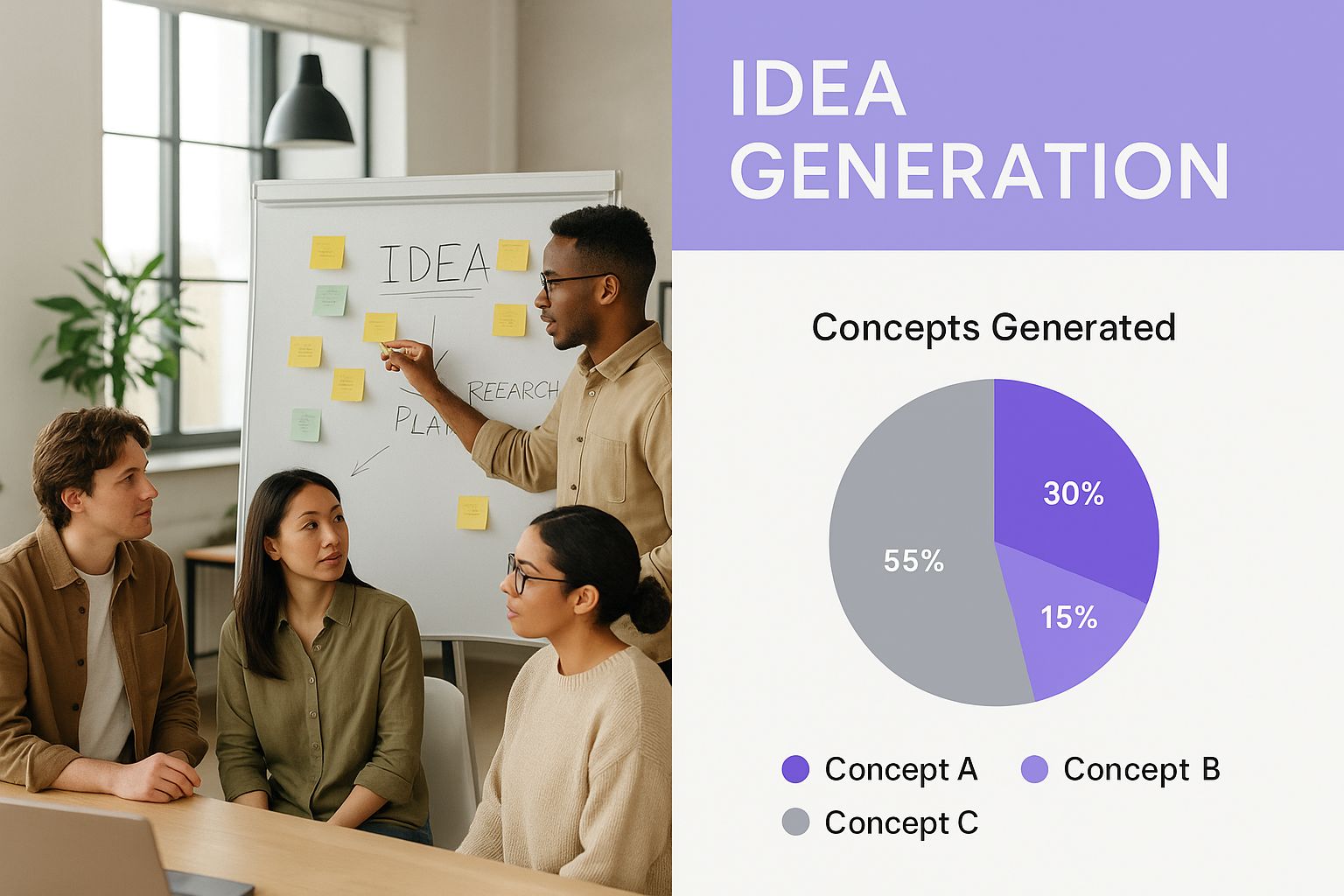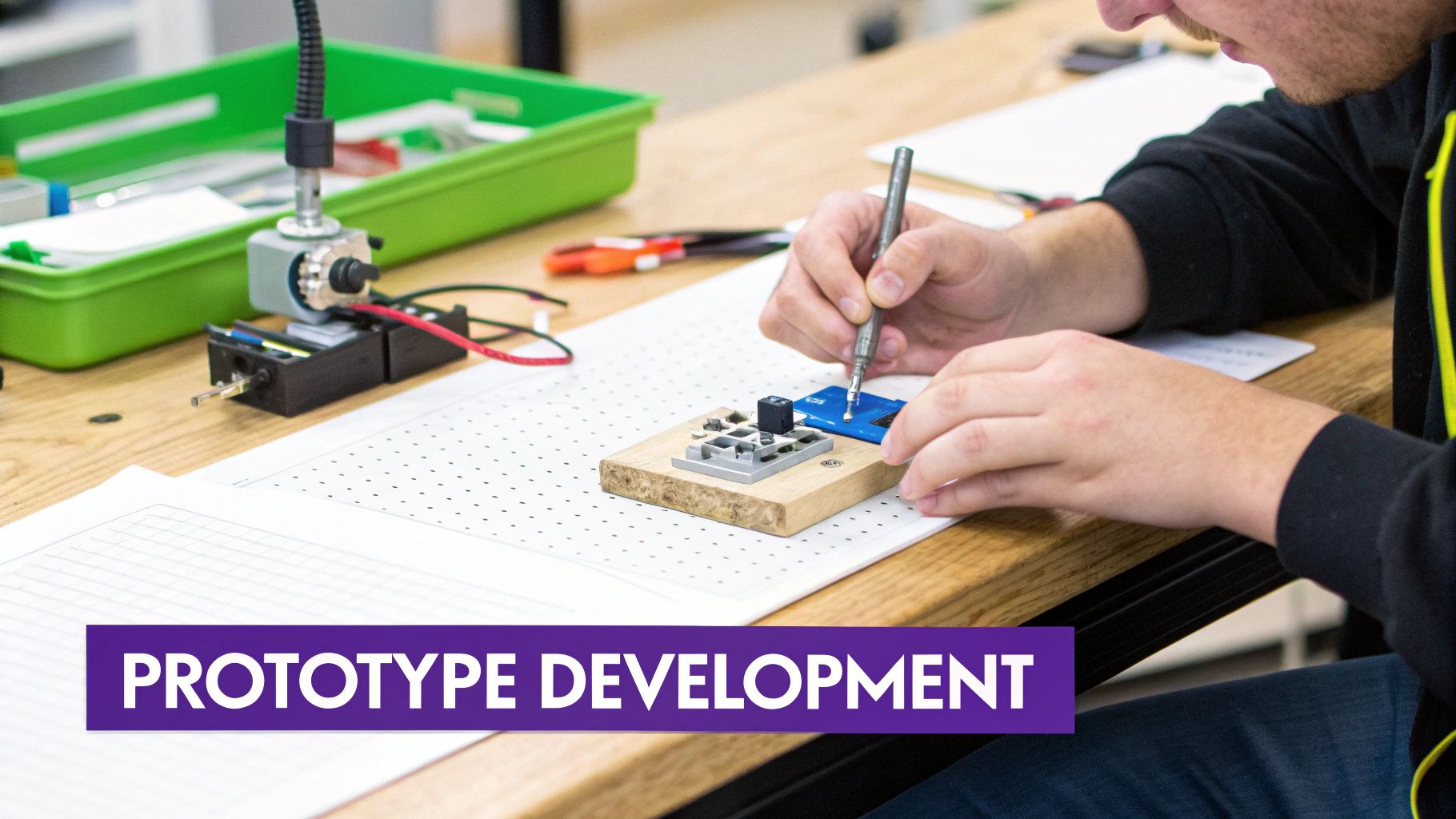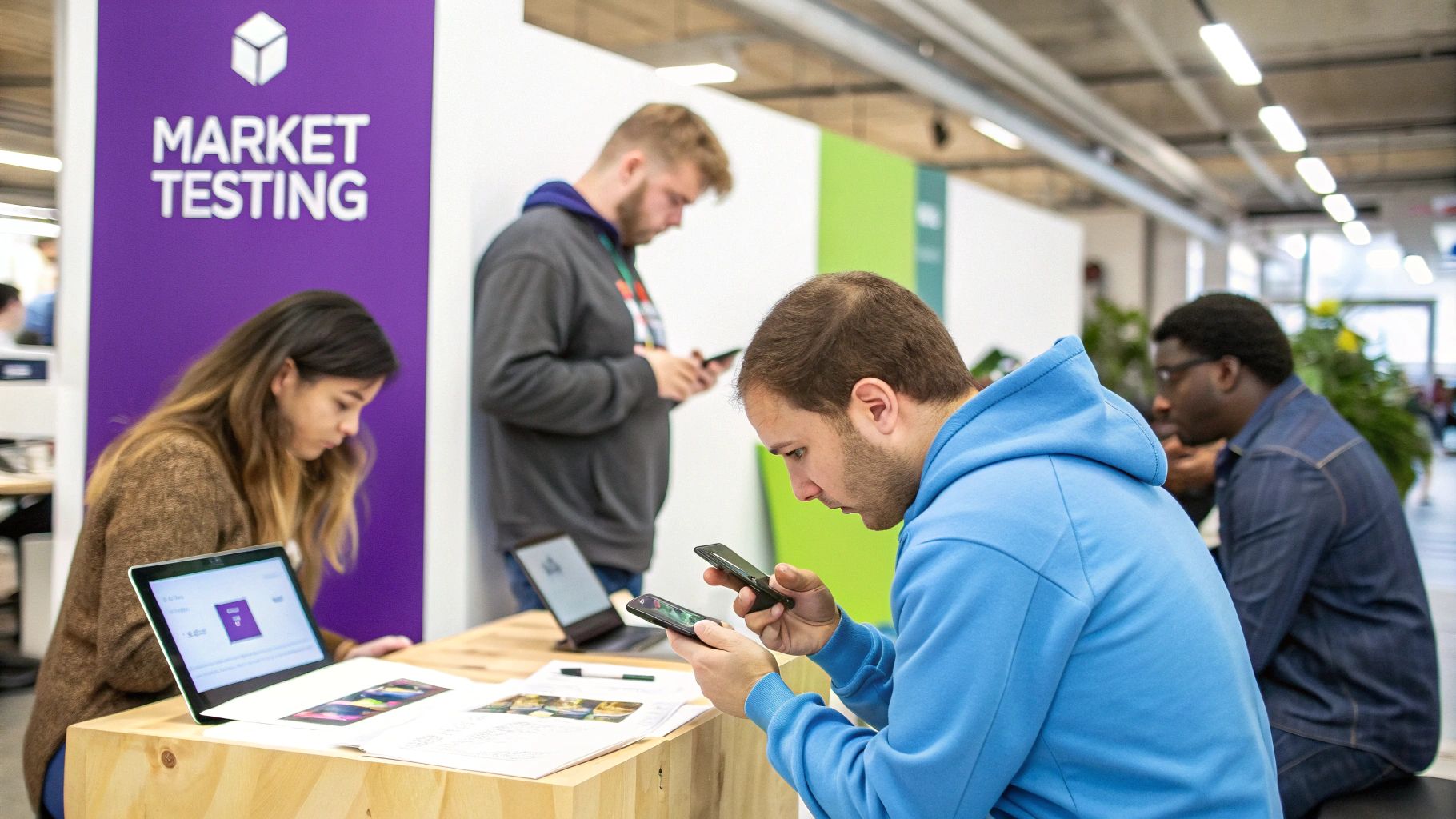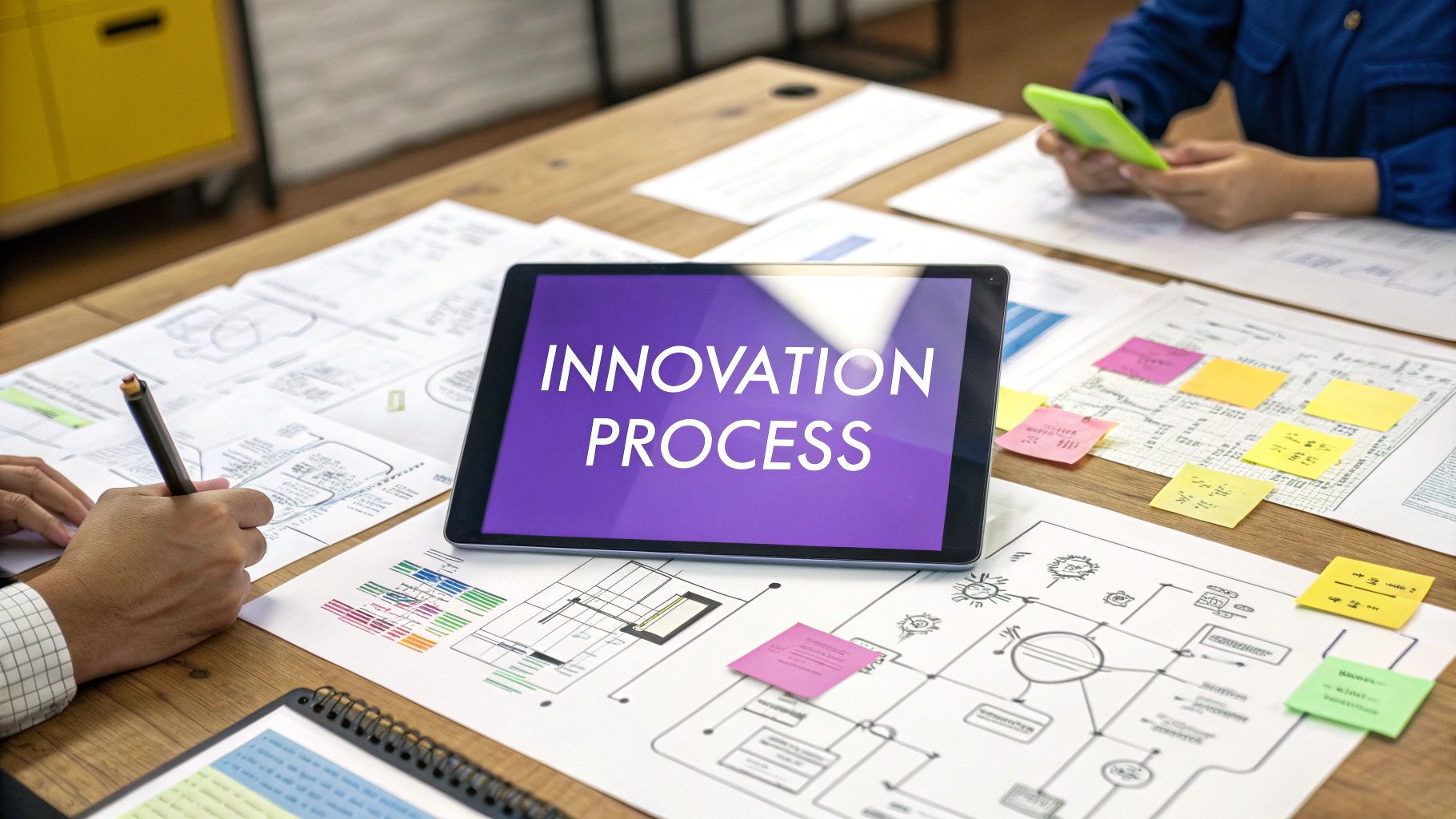Innovation isn't just about a single "aha!" moment. It's a structured journey. The best processes of innovation are like a reliable roadmap, guiding teams from a rough idea all the way to a real-world solution that people actually want. These frameworks take the messy, unpredictable nature of creativity and give it a clear, repeatable path to follow.
Think of it like this: you wouldn't build a house without a blueprint. You’d have a plan, specific phases for the foundation and framing, and inspections at every critical stage. Innovation processes do the same for your ideas, providing the essential steps and checkpoints to turn a concept into a successful product or service.
Different projects require different blueprints. Whether you're trying to figure out a tricky customer problem, launching something completely new in a volatile market, or steering a massive internal project, there's a framework built for the job. These systems help turn creative sparks into tangible results by setting clear directions and defining key decision points along the way.
So, Why Bother With a Framework?
At their heart, innovation frameworks bring a bit of order to the beautiful chaos of creation. They help teams do three crucial things:
- Slash the Risk: By testing your big assumptions and getting feedback early and often, you stop yourself from pouring time and money into ideas that are destined to fail.
- Build Consistency: A clear process means good ideas don't fall through the cracks. It keeps projects moving forward, even when things get complicated.
- Get Everyone on the Same Page: When the whole team is working from the same playbook, there's a shared understanding of the goals, the stages, and who's responsible for what.
This is especially true right at the beginning, during the idea generation phase. It’s where diverse teams and perspectives come together to shape those first concepts, a cornerstone of any innovation process.

As the image shows, great innovation starts with people brainstorming together. If you want a deeper look at how these initial thoughts grow into fully-fledged solutions, you can explore our guide on mastering the steps in the innovation process.
A good process doesn't kill creativity—it channels it. By clearing the path, these frameworks give your team the mental space to focus on what really matters: solving real problems and delivering value.
Since different challenges need different tools, it helps to know which framework fits your situation. We'll be diving into the big three, but here’s a quick snapshot to get you started.
Quick Guide to Key Innovation Processes
This table offers a side-by-side look at the three core innovation frameworks, comparing their primary goals and the best scenarios for using each one.
| Innovation Process | Main Goal | Ideal Use Case |
|---|---|---|
| Design Thinking | Solve complex problems by deeply understanding user needs and experiences. | When the problem is fuzzy or poorly defined and you need a human-centered solution. |
| Lean Startup | Find a sustainable business model by testing assumptions with real users. | For new ventures or products launching into a market full of unknowns. |
| Stage-Gate | Manage risk in large projects by making go/no-go decisions at key milestones. | For complex, high-investment projects, typically within established companies. |
Think of this as your cheat sheet. As we go through each one, you’ll get a much clearer picture of how they work and which might be the perfect fit for your next big idea.
Why Your Business Needs a Structured Process
Relying on random flashes of inspiration isn't a strategy—it's a gamble. We all love the story of the lone genius having a sudden "eureka!" moment, but real, sustainable growth comes from disciplined, repeatable processes of innovation. Without a clear framework, businesses often find themselves spinning their wheels and wasting resources on ideas that simply go nowhere.
Think about two companies. Let's call the first one "Chaos Inc." They chase every shiny new idea that pops up. Their brainstorming sessions are full of energy, but they're completely unstructured, resulting in a dozen exciting concepts. The problem? With no clear path forward, teams burn out trying to develop everything at once, money gets spread too thin, and most projects fizzle out before a single customer ever sees them.
Now, let’s look at "Structure Corp." This company uses a formal process for innovation. When a new idea comes up, it enters a system designed to vet, test, and refine it. Each concept has to pass through specific checkpoints, proving its value before more time and money are invested. This structured approach doesn't kill creativity; it channels it into something productive.
From Gambling to a Growth Engine
A formal process turns innovation from a lottery ticket into a predictable engine for growth. It creates clear go/no-go decision points, making sure that resources are only spent on the most promising ventures. It's no surprise that 85% of executives say a fear of risk holds back innovation in their companies. A solid process helps manage that fear by making the journey measurable and transparent.
This kind of system also creates alignment. When everyone on the team understands the stages, the criteria, and the end goals, they can work together without friction. Instead of debating which idea is "best" based on gut feelings, decisions are guided by actual data and customer feedback.
A defined process builds a true culture of innovation, empowering every team member to contribute valuable ideas within a system designed for success. It’s about channeling creativity, not stifling it.
Building a Culture of Purposeful Innovation
At the end of the day, the goal is to create a system where good ideas can actually survive and thrive. This takes more than just a checklist; it requires a company-wide mindset shift that values validated learning over raw, unchecked enthusiasm. A strong innovation process is often woven into a complete new product development strategy that guides an idea all the way to a finished product.
The benefits of moving to a more structured approach are hard to ignore:
- Reduced Waste: You stop spending time and money on projects that lack real potential.
- Faster Learning: Teams can quickly figure out what works and what doesn't.
- Increased Success Rate: Ideas are properly tested and improved long before they launch.
- Team Empowerment: Everyone knows exactly how they can contribute to innovation.
By putting a formal framework in place, you’re not just managing ideas; you're building a more resilient, forward-thinking organization. If you want to dig deeper into this core concept, our guide on why innovation is a process provides a much fuller picture. It’s the difference between just hoping for success and actually engineering it.
Getting to Grips with Design Thinking
Of all the ways to innovate, Design Thinking is one of the most powerful because it puts people first. It’s less of a rigid formula and more of a mindset—a way of looking at problems through the eyes of the people you’re trying to help. Think of yourself as a detective trying to understand someone's real, unspoken needs, not just the problems they complain about.
Instead of jumping straight to a solution, this framework makes you start with understanding. It's a hands-on, cyclical process that guides you from deep user empathy all the way to a tested, tangible solution. This approach is famous for helping teams build products that customers don't just use, but actually love.

Stage 1: Empathize
Everything starts with empathy—the simple, yet profound, act of stepping into someone else’s shoes. The goal here isn't just to collect data; it's to gain a genuine understanding of your users' experiences, their motivations, and what truly frustrates them. You have to see the world from their perspective.
A classic example is the story behind OXO Good Grips. The founder, Sam Farber, simply watched his wife, who had arthritis, struggle with a vegetable peeler. That single moment of observing her frustration and empathizing with her daily challenge was the spark that led to an entire line of user-friendly kitchen tools.
To build this kind of empathy, teams often rely on a few key tools:
- User Interviews: These aren't just Q&A sessions. They're conversations meant to uncover the stories and emotions behind a person’s actions.
- Observation: Simply watching people use a product or navigate a space in their own environment can reveal insights you’d never get from a survey.
- Journey Mapping: This involves visualizing every single step of a user's experience to pinpoint the highs and lows.
Stage 2: Define
Once you've gathered all those rich, human insights, it's time to make sense of them. The Empathize stage often leaves you with a messy collection of observations and anecdotes. In the Define stage, you sift through it all to nail down the core problem you’re going to solve.
A weak problem statement is broad, like "design a better peeler." A strong one is focused on a human need. For OXO, a good problem statement might have been: "People with limited hand strength need a way to grip kitchen tools comfortably and safely." See the difference?
A well-defined problem statement becomes your North Star. It keeps the entire team focused on a specific, human-centered goal and ensures that the ideas you come up with are actually relevant.
Stage 3: Ideate
With a clear problem in your sights, the fun begins. The Ideate stage is all about generating as many ideas as possible—no judgment allowed. At this point, you want quantity over quality. Go wide and explore every potential solution, from the practical to the absurd.
This is where you break out the brainstorming techniques. One of the most popular is framing questions as "How Might We…?" For instance, instead of saying "make a grippier handle," you'd ask, "How might we design a handle that requires less force to hold?" This small shift in language opens up a world of creative possibilities.
For remote teams, brainstorming can feel clunky. That's where a tool like Bulby comes in. It's built to guide remote teams through AI-powered exercises that make sure everyone’s voice is heard, helping you push past the obvious ideas to find something truly unique.
Stage 4: Prototype
Ideas on their own are just talk. The Prototype stage is where you start making them real. A prototype is simply a scaled-down, testable version of your product. It doesn't have to be fancy—it could be a series of paper sketches, a physical model made of cardboard, or a clickable digital mockup.
The point is to create something tangible that users can actually interact with. You're not aiming for perfection; you're aiming for learning. By building a quick, low-cost prototype, you can test your biggest assumptions before you sink a ton of time and money into development. It’s a crucial step in taking the risk out of innovation.
Stage 5: Test
Finally, you put your prototype into the hands of real users and see what happens. This is where the rubber meets the road. You’ll get honest, unfiltered feedback on what works, what doesn’t, and what’s just plain confusing.
The insights you gather here are pure gold. More often than not, they’ll send you back to an earlier stage in the process. Maybe your prototype was difficult to use, or maybe it didn't solve the problem as elegantly as you thought. That’s okay! This iterative loop of prototyping and testing is the engine of Design Thinking. It’s what helps you refine your solution until it's polished, user-approved, and truly ready to shine.
Applying the Lean Startup Methodology
If Design Thinking is all about falling in love with the customer's problem, then the Lean Startup methodology is about finding out—as quickly and cheaply as possible—if your solution is the right answer. It’s one of the most effective processes of innovation because it forces you to treat your big idea not as a brilliant plan, but as a scientific hypothesis that needs to be proven in the real world.
This whole approach is built around a simple, powerful cycle: Build-Measure-Learn. Instead of locking your team away for a year to build the "perfect" product, you create the smallest, most basic version of your idea, put it in front of real people, and see what happens. You measure their reactions, learn from their behavior, and repeat. This relentless loop helps you avoid the number one reason startups fail: building something nobody actually wants.
The Build-Measure-Learn Feedback Loop
Think of this cycle as a constant conversation with your target market. Each trip around the loop is a new experiment designed to turn your guesses into facts.
- Build: First, you build a Minimum Viable Product (MVP). This isn't your final, polished product. It’s the absolute bare-bones version that still solves a core problem for your earliest customers.
- Measure: Once the MVP is out there, you start collecting data. Forget vanity metrics like website visits. You need to know how people are actually using your product. Are they coming back? Are they completing key actions?
- Learn: This is where the magic happens. You take that data and gain validated learning. Did your experiment work? Did you prove your core assumption? Based on what you’ve learned, you make a tough call: do you persevere and keep pushing in the same direction, or do you pivot and change course?
This fast, iterative process helps you find a real market for your product before you burn through all your time and money.
The Power of the Minimum Viable Product
The MVP is the heart and soul of the Lean Startup. It's built to test your riskiest assumption with the least amount of effort. The story of Zappos is a classic example.
Founder Nick Swinmurn didn't start by building a massive warehouse and buying millions of dollars in shoe inventory. Instead, he went to local shoe stores, took photos of their shoes, and posted them on a simple website. When someone placed an order, he'd literally run to the store, buy the shoes, and ship them out himself. It wasn't a real business yet, but this simple MVP perfectly tested his biggest question: "Will people buy shoes online?" The answer was a clear yes, and that single piece of validated learning gave him the confidence to build the company.
The point of an MVP isn't to build a smaller version of your final product. It's to build an experiment that helps you learn as fast as possible.
Tools for the Lean Startup Process
To run these experiments effectively, teams use a few key tools to keep their thinking sharp and their efforts focused.
- The Lean Canvas: This is a one-page business plan that breaks your idea down into its core assumptions. It covers everything from the problem you're solving to how you'll make money. To get started, check out our guide on what is a Lean canvas and how to build one.
- A/B Testing: This lets you compare two versions of something—a webpage, a feature, an email—to see which one performs better. It’s a fantastic way to make data-driven decisions instead of just guessing.
- Validated Learning Metrics: Focus on numbers that prove genuine customer engagement. Think activation rates (are people getting started?), retention (are they coming back?), and referrals (are they telling their friends?).
Showcasing your MVP with a clear demo is also a great way to get feedback without spending a fortune on development. Using a product demo video maker can help you quickly create something compelling to test your concepts. By systematically testing every piece of your business, the Lean Startup method turns innovation from a gamble into a science.
Your Guide to the Stage-Gate Process
When you're working on a big, complex project where failure is simply not an option, you need a different kind of playbook. Enter the Stage-Gate process. Think of it less like a free-flowing brainstorming session and more like a pre-flight check for a mission to Mars. Every single part is tested, verified, and signed off before the next phase can even begin.
This method brings a much-needed dose of structure and risk management to the kinds of ambitious, high-investment projects you often see in large companies. It's a classic approach that breaks down a massive undertaking into a series of smaller, more manageable stages (where the work happens) and critical decision points called gates (where you decide if the project continues).

This systematic approach is designed to weed out weaker ideas early on. The goal is to make sure your most valuable resources—time, money, and talent—are only poured into the projects with the highest chance of success.
How Stages and Gates Work Together
The entire process is a rhythm of doing and deciding. The stages are for action, and the gates are for evaluation. It's a simple but powerful loop.
- Stages: This is where your team rolls up their sleeves and gets to work. During a stage, they might be doing market research, tackling technical development, or putting together a detailed business case.
- Gates: Picture a gate as a formal review meeting. At the end of each stage, the project team presents what they’ve accomplished to a panel of senior leaders. The project is then judged against a clear, pre-agreed set of criteria.
This structure keeps everyone on the same page and makes the whole process transparent. It's a fantastic way to manage a large portfolio of innovation projects without letting things get chaotic.
The Five Core Stages of the Journey
While you can always tailor the process to fit your needs, a typical Stage-Gate model follows five key stages, taking an idea from a simple concept all the way to a full-blown market launch.
- Scoping: This is a quick, initial look at the idea. You're doing a preliminary check to see if the project has technical merit and if there's a real market for it.
- Build Business Case: Time for a much deeper dive. The team conducts thorough research to define the product, justify the investment, and map out a solid plan.
- Development: Here’s where the magic happens. The plan turns into a real, tangible product as your team gets into the design and development work.
- Testing and Validation: The prototype gets put through its paces. It’s rigorously tested, both internally and with actual customers, to make sure it works perfectly and solves a real problem.
- Launch: The final push. This stage covers everything needed to get the product out into the world, from marketing and sales to scaling up production.
If you're looking to bring this kind of structure to your own team, our guide on how to build your innovation management process offers practical steps that work hand-in-hand with the Stage-Gate framework.
At every gate, the decision is crystal clear: Go, Kill, Hold, or Recycle. This ruthless discipline stops "zombie projects"—those that should have been stopped long ago—from sucking up resources.
Making the Tough "Go" or "Kill" Decisions
The whole Stage-Gate process lives or dies by the quality of its gates. These meetings aren't just status updates; they are serious business decisions that determine a project's future. For them to work, they have to be driven by data, not just gut feelings.
This is where a strong R&D focus becomes crucial. You need hard data to make informed decisions. In fact, research shows that a country's R&D investment and industrial strength are huge factors in how quickly it can adopt new technologies. The lesson here is that solid, foundational investment is what drives successful outcomes. You can explore more on how R&D prepares countries for new technologies.
The same logic applies within any company. The projects with the best data and the right resources are the ones that perform. For any organization trying to manage significant risk, the Stage-Gate process adds a layer of discipline that ensures every big bet is a smart one.
How to Choose the Right Innovation Process
Trying to pick one of the leading processes of innovation isn't about finding a single "best" method. Think of it more like a carpenter choosing the right tool for the job—you wouldn't use a hammer to cut a board. The best process is simply the one that fits the challenge you're facing.
To make the right call, you have to step back and look at the big picture. Are you trying to crack a brand new market where everything is uncertain? Or are you focused on tweaking an existing product inside a big, established company? Each situation demands a different approach.
Key Factors in Your Decision
Choosing your framework really boils down to asking a few honest questions about your project and your organization. Your answers will naturally point you in the right direction.
Think about these key factors:
- Problem Clarity: How well do you actually understand the problem? Is it a fuzzy, undefined feeling of customer frustration, or is it a specific, technical hurdle?
- Market Uncertainty: Are you wading into a familiar market with known competitors, or are you creating an entirely new category where nobody knows how customers will react?
- Risk Level: What’s on the line here? Are you placing a small bet with a tiny team, or are you pouring millions into a massive product launch?
- Company Size and Culture: Is your company a small, nimble startup that can turn on a dime, or a large corporation that needs structure and predictable outcomes?
Comparing the Core Frameworks
Here’s a simple table to help you compare Design Thinking, Lean Startup, and Stage-Gate based on those key factors. Think of it as a cheat sheet for your decision.
| Factor | Design Thinking | Lean Startup | Stage-Gate |
|---|---|---|---|
| Problem Clarity | Best for unclear or human-centered problems | For when the solution is unclear, not the problem | Best for well-defined project goals and scope |
| Market Uncertainty | High—helps you discover unmet needs | Very high—designed to find a business model | Low—works best in predictable, known markets |
| Risk Level | Low to medium—focused on low-cost learning | High, but manages risk through fast iteration | Very high—manages large financial investments |
| Company Size | Adaptable to any size | Ideal for startups and small, agile teams | Best suited for large, established organizations |
Creating Powerful Hybrid Models
Here’s a secret: the most innovative companies rarely stick to just one process. They get creative and build their own hybrid models, borrowing the best pieces from each framework to create something that works for them. For example, you might kick things off with Design Thinking to really get inside your customer's head, then pivot to a Lean Startup MVP to quickly test your big idea.
This kind of flexibility is everything. The most successful innovation programs are often the most adaptable, shaped by everything from internal governance to industry-wide trends. In fact, research shows that innovation blooms where business strategy and even societal decisions create an environment ready for change. If you're curious, you can read more about how governance shapes global innovation.
At the end of the day, your goal is to build a process that clicks with your team and your company culture. Once you understand the strengths of each framework, you can mix and match to give your ideas the best shot at success. And as you get going, don't forget to keep score—learning how to measure innovation is the only way to know if your new process is actually working.
Frequently Asked Questions
It’s one thing to understand the theory behind innovation frameworks, but putting them into practice is a completely different ballgame. Here are some straightforward answers to the questions we hear most often from teams just getting started.
Can a Small Business Use a Formal Innovation Process?
Absolutely. It's a common misconception that frameworks like Stage-Gate are only for giant corporations with deep pockets. The truth is, the core ideas behind any good innovation process can be scaled to fit any size team.
The trick for a small business isn't to copy a corporate giant's rulebook but to borrow the essential principles. You don't need a massive, bureaucratic system. Instead, focus on the spirit of the framework. A small team can run a Design Thinking sprint with just a handful of customer interviews, or test an idea with a simple landing page, Lean Startup style. The key is to stay nimble.
For small businesses, the best innovation processes are lightweight and flexible. They offer just enough structure to guide smart decisions without bogging down a fast-moving team.
How Do I Get My Team to Adopt a New Process?
Getting your team on board is everything. If you just announce a new process and expect everyone to fall in line, you're setting yourself up for failure. A collaborative approach is always better.
Start with the "why." Clearly explain the problems you're trying to solve. Are you trying to cut down on wasted work? Get closer to what customers actually want? When people understand the reason for the change, they’re much more likely to get behind it.
Here are a few practical steps to take:
- Run a small pilot project: Pick one low-stakes project and test the new framework. This gives everyone a chance to learn in a safe environment without massive pressure.
- Shout out the early wins: Did the pilot uncover a critical insight? Did it save the team from heading down the wrong path? Share those successes! It builds momentum and proves the new process isn't just busywork.
- Let the team help shape it: Ask for feedback. Give your team the power to tweak the framework so it genuinely fits your company's culture and the way you work.
What Is the Biggest Mistake to Avoid?
The single biggest trap is treating an innovation framework like a rigid, unchangeable set of rules. These are meant to be guideposts, not straitjackets.
The moment your team becomes more obsessed with ticking boxes than with actually learning and adapting, the process has failed. Instead of sparking creativity, it's smothering it. Innovation is messy by nature. A good process should provide clarity and focus, not create more red tape. If the framework is getting in the way, it’s time to change it.
Should Our Innovation Process Ever Change?
Yes, and it should change often! Your innovation process isn't set in stone. The framework that works for you today might not be the right fit a year from now. Your team will grow, the market will shift, and your goals will change.
Make it a habit to review your process every quarter or so. Ask the tough questions: Where are the bottlenecks? Is this still helping us make good decisions? Constantly improving your own process is what keeps it a powerful tool for growth, not just another binder on the shelf.
Ready to transform your team's creative sessions? Bulby provides the structure and AI-powered guidance to make your remote brainstorming more effective and inclusive. Discover how Bulby can guide your next great idea.

